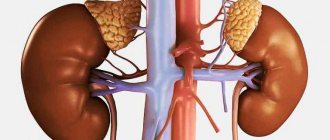The organs of the digestive system are mostly concentrated in the abdominal cavity, so ultrasound of the abdominal cavity affects the quality of each other’s display. Independent preparation of the body for ultrasound of the abdominal organs
necessarily includes a strict diet. The doctor explains in detail how to prepare. We will focus on general recommendations.
Proper diet before abdominal ultrasound
The diet before an abdominal ultrasound is based on fractional meals. This means that you can eat food in small portions every three hours. This reduces the load on the digestive system.
Why do you need a diet?
A diet that determines what exactly and in what quantities can be eaten on the eve of an abdominal ultrasound is required to improve visibility during the procedure so that the organs of the abdominal cavity and abdominal space are visible as clearly as possible. The diet before an abdominal ultrasound is designed to minimize scanning errors and free the intestines from waste products. However, the main purpose of the diet is to prevent flatulence, which is a significant obstacle to examination of the abdominal organs.
What menu is recommended before an ultrasound?
Compliance with the diet is mandatory when examining the organs of the genitourinary system and gastrointestinal tract. Products that increase gas formation include:
- bakery products using yeast;
- alcohol;
- soda – lemonade, mineral water;
Coffee and cakes will have to be excluded from the diet
- sweets;
- smoked, spicy, salted, fried foods;
- fatty meats;
- milk, cottage cheese with high fat content;
- porridge with milk;
- junk food (burgers, fries);
- strong tea or coffee;
- juices from the store;
- vegetables, coarse fruits (cabbage, onions, sorrel, turnips, radishes, radishes, gooseberries).
You are allowed to eat low-fat foods:
- cereals – buckwheat, millet;
- milk and its products with low fat content;
- chicken;
- vegetable soups;
- tea with chamomile.
Before an ultrasound, you can safely eat buckwheat porridge.
It is best to cook food by steaming or in the oven.
An approximate menu for 1 day is shown in the table.
| Eating | Products |
| Breakfast | 1 boiled egg, green tea |
| Snack | Low-fat cheese, a glass of clean still water |
| Dinner | Lean meat, boiled in slightly salted water (or steamed), compote |
| Afternoon snack | Porridge |
| Dinner | Lean fish, steamed or baked in foil, still water |
When to start preparing?
It will take at least three days to cleanse the organs of the digestive system, so preparation for an ultrasound begins three days before the procedure. For gastrointestinal problems such as constipation and indigestion, it is better to adjust your diet earlier before an abdominal ultrasound.
What to eat three days before the examination?
Three days before the procedure, the diet for ultrasound of the abdominal organs involves eating lean boiled meat: quail, chicken, beef. The body needs easily digestible protein, so you should eat low-fat fish: it can be boiled in the traditional way or in a double boiler, or baked in foil without oil. And what you can definitely eat before an abdominal ultrasound is unsweetened porridge with water: pearl barley, oatmeal, buckwheat. One chicken egg every day is acceptable in the diet before an abdominal ultrasound. It is advisable to drink still water or slightly sweetened tea between meals.
The day before the ultrasound
The above-described diet continues until the evening of the third day, if an ultrasound of the abdominal cavity is supposed to be done in the morning. It is advisable to take a laxative and do an enema between 16:00 and 18:00. Is it possible to eat immediately before an abdominal ultrasound? The doctors' answer is unequivocal: it is impossible, since the stomach must be completely free of remnants of food and liquids. If an abdominal ultrasound is scheduled for after 3:00 p.m., it is permissible to eat a light breakfast before 8:30 a.m.
What can distort the picture?
Proper preparation for an ultrasound is necessary in order to reduce the risk of distortions in the final image. It is worth knowing that factors such as gases in the intestines, active movement during the examination, internal spasms, and excess weight can make the result of the procedure unclear.
Some important nuances
Half a day before the procedure, you must do an enema or use a laxative to cleanse the intestines. You should not smoke several hours before the ultrasound, because nicotine causes spasms of the internal organs. It is also not recommended to use chewing gum. When planning an ultrasound of the genitourinary system, on the contrary, you should drink a liter of still water shortly before the procedure. You can't urinate afterwards. It is better to reschedule the test if you have recently had an x-ray or colonoscopy.
How is the procedure done?
An abdominal ultrasound is a comprehensive procedure that shows the condition of all abdominal organs: liver, pancreas, gallbladder, kidneys, spleen. An abdominal ultrasound also evaluates the condition of the stomach and upper duodenum. An ultrasound of the abdominal cavity clearly shows the aorta, namely its abdominal section. This examination method, when carried out correctly, does not cause discomfort, since the doctor moves the scanner over the patient’s abdomen lubricated with a special gel.
There is no need to prepare for the procedure, since disposable wipes are available in the ultrasound room. The scanning begins in a supine position, after which the sonologist asks the subject to turn first to the left and then to the right side. During the procedure, the doctor records the information received, and the conclusion is given to the patient. However, the sonologist does not make diagnoses - this is done by the attending physician.
Nutrition before ultrasound
Before going for an ultrasound, you need to eat exclusively the foods presented below. Once absorbed by the body, they do not emit gases and do not interfere with diagnostics. These products include:
- Oatmeal, pearl barley, rice and buckwheat porridge.
- Boiled chicken or beef.
- Low-fat boiled fish.
- Dietary cheese.
- Boiled egg (1 piece per day).
Eat 4-5 times a day in small portions, chewing food thoroughly.
Wash down your meal with still water, juice or weak tea.
Preparation for abdominal ultrasound in children
Young parents are concerned about whether their children can eat before an abdominal ultrasound. Due to the physiological characteristics of the child’s body, preparation for an ultrasound of the abdominal cavity
determined by the age of the child. Infants should not eat three hours before the procedure; for children under three years of age this time period is four hours. Children from three to fourteen years old can easily tolerate a six-hour food refusal. In this case, the diet before abdominal ultrasound should, if possible, be followed for three days before the procedure.
Sample menu for the day
First of all, you need to carefully balance your four-day daily food intake before the ultrasound:
- Breakfast. One glass of weak tea and one hard-boiled egg.
- Dinner. A serving of steamed chicken or beef, a glass of water or tea.
- Afternoon snack. One bowl of porridge.
- Dinner. A small portion of lean boiled or steamed fish.
Introduction
Everyone knows that ultrasound remains to this day not only one of the most informative examination methods, but also a non-invasive, painless and safe way to find out all the details about the patient’s health and condition.
However, not everyone knows, for example, that you should not eat or drink before an abdominal ultrasound, how best to prepare for it so that the data is as informative and reliable as possible, and what the diet should be before such an examination as an ultrasound.
The main obstacle to the procedure is the presence of excess air in the intestines, so the patient’s primary task is to remove it . The outcome greatly depends on the thoroughness of the preparation.
Disadvantages of the method
Ultrasound is not a unique method of research and diagnosis. Therefore, it has its significant disadvantages. The main ones include:
- Compared to MRI or CT, this method has a fairly low image resolution on the screen.
- Ultrasound cannot simultaneously show a complete diagnostic picture due to the small examination area.
- All human internal organs are heterogeneous, so the ultrasound image contains a large amount of noise and picture defects.
- In order to get the desired result, you must adhere to a diet, take the necessary medications and come for diagnostics on an empty stomach.
What drugs help the research?
To reduce the likelihood of distortion of the ultrasound picture when examining the abdominal organs, the following medications can be used in consultation with the doctor:
- Carminatives based on simethicone to reduce gas formation - “Espumizan”, “Infacol”, “Disflatil”. The dosage should be specified in the instructions. For example, Espumisan is taken 3 capsules 3-4 times a day for 3 days. Simethicone acts only in the intestines and has no systemic effect.
- Sorbents for removing toxins and fermentation products - “White Coal”, “Smecta”, “Enterosgel”. One of the medications should be taken the evening before and 3 hours before the morning of the test.
- Enzymes that facilitate the absorption of food - “Mezim”, “Festal”, “Creon”. They should be drunk during meals 3 times a day for 2 days. For pancreatitis, use is not recommended.
- Laxatives based on herbal raw materials - “Senade”, “Fortrans”. If you are prone to constipation, the drug should be taken the evening before the test. Medicines containing lactulose should not be taken as they increase gas formation.
When preparing for an ultrasound of a child, you can use children's analogues of the listed drugs in age-appropriate dosages. Medication support must be agreed upon with the pediatrician.
Ultrasound of the abdominal cavity allows you to quickly assess the condition of the gastrointestinal tract and kidneys without causing discomfort to the patient. It is extremely important to follow the rules of preparation for scanning, especially those related to nutrition. Otherwise, an erroneous result may be obtained, which will lead to the prescription of inappropriate treatment.
Did you know that kidney pain can easily be confused with spinal pain? My right kidney hurts - what to do and how to correctly determine the location of the pain?
We will look at the reasons for the localization of pain in the left kidney using the link.
What is not recommended to eat and drink before an ultrasound?
What should you not eat before an abdominal ultrasound? For 3 days before the ultrasound, the following should be excluded from the diet:
- Whole milk and fermented milk products. Excess milk sugar (lactose) in the intestines causes fermentation. Moreover, with age, the amount of the enzyme that breaks it down decreases.
- Fruits and berries with a sweet taste - apples, pears, figs, cherries, peaches, bananas. They contain fructose and fiber, which promote flatulence.
- Starchy fruits (potatoes, corn), onions, asparagus and any variety of cabbage. They contain a lot of polysaccharides.
- Juices from the mentioned vegetables and fruits.
- Black rye bread, pastries, factory-made sweets. These products contain carbohydrates, as well as various synthetic additives that provoke fermentation and can irritate the walls of the gastrointestinal tract.
- Legumes – soybeans, peas, lentils, beans. They are saturated with plant protein and polysaccharides, which are difficult to digest by the body. When they are digested, a lot of gases are released.
- Fatty meats and fish. The accumulation of fats in the intestines provokes prolonged absorption of food and its rotting.
- Carbonated drinks. The carbon dioxide they contain accumulates in the gastrointestinal tract. In addition, such drinks always contain a lot of harmful chemical additives (stabilizers, dyes, preservatives) that irritate the mucous membrane.
- Cinnamon, cumin, pepper and some other spices, as well as coffee and alcohol. They negatively affect the condition of the inner layer of the gastrointestinal tract.
What the study will show
With proper preparation for the ultrasound procedure, you can determine the following:
- determine the causes of abdominal pain;
- assess liver health;
- examine the gallbladder and the paths along which bile passes; determine the presence of stones in them, find out whether they have inflammation or cicatricial narrowing;
- identify the presence of organic kidney damage;
- determine the presence of stones in the kidneys, ureters, and bladder;
- examine the pancreas;
- assess the condition of the aorta - the largest arterial vessel of the peritoneum, determine the presence of ascites in diseases of the liver or peritoneum;
- identify acute appendicitis (this is very important in case of unclear diagnosis, especially in children);
- examine organs after physical damage or injury;
- If you carefully study what to do before this ultrasound, the study will help you prepare for abdominal surgery. It is also considered invaluable in post-biopsy monitoring.
Ultrasound of the peritoneum can be performed as often as necessary to identify the diagnosis and monitor the effectiveness of treatment: the method is completely safe and harmless, ultrasound does not change anything in your cell structure. If necessary, the specialist may order an ultrasound examination for several days in a row.
This procedure can be done free of charge in a city clinic or hospital upon referral from the attending physician. In multidisciplinary medical institutions and specialized clinics, you can undergo a paid ultrasound scan. Today there is such a service as performing ultrasound at home .
This service allows you to carry out the procedure at home around the clock.
Purgation
Cleansing the intestines is something that must be done before performing an ultrasound of the retroperitoneal space and abdominal cavity. It is carried out in the evening before the study. It is carried out using an Esmarch mug and a liter - one and a half liters of cool (not warm) raw water.
After such cleaning, you need to drink sorbents or simethicone preparations 1-2 times.
An alternative to a cleansing enema are the following methods:
- Herbal laxatives (for example, based on hay - “Senade”).
- The drug “Fortrans”, a sachet of which is designed for 20 kg of the weight of a person over 14 years of age. The contents of the package should be dissolved in a liter of cool water and drunk within an hour. That is, if you weigh 60 kg, you need to drink 3 packets in 3 hours from 16:00 to 19:00 (or earlier)
- Microclysters “Norgalax”, “Microlax”.
The essence and purpose of ultrasound
Abdominal ultrasound is an informative and non-invasive method for examining the condition of internal organs
The diagnostic method uses high-frequency sound vibrations to visualize various organs and cavities of the human body. The sound waves used in the diagnostic method are reflected from the structures of the internal organs and form an image on the screen using feedback. Abdominal ultrasound is used to visualize almost all digestive organs.
Ultrasound examination is absolutely painless. The method is used everywhere; without this procedure, surgical operations and other medical procedures are impossible.
The peculiarity of ultrasound diagnostics is that the method provides visualization of structures in real time. The doctor sees on the monitor the structures of organs and their movements, as well as features of blood flow and blood vessels. Ultrasound is especially useful for diagnostic testing of the fetus during pregnancy.
Ultrasound diagnostics of the abdominal cavity is used to assess the condition of the abdominal organs. The method best visualizes the gallbladder, kidneys, liver, pancreas and spleen. This is a standard diagnostic test used both for preparation for abdominal surgery and for routine examination of the patient.
The ultrasound method helps to identify acute and chronic pathologies of the digestive system.
This is a fairly cheap and simple test, so it is prescribed for any signs of the disease. Despite its simplicity, the method makes it possible to detect life-threatening pathologies and help the patient in a timely manner. Abdominal ultrasound is often used to detect an abdominal aortic aneurysm. This serious condition can be complicated by excessive bleeding and death.
From the video you can learn how an abdominal ultrasound is performed:
Indications for:
- Blockages of blood vessels.
- Enlargement of organs (especially the liver, spleen and kidneys).
- Fluid in the abdominal cavity.
- Gallstones.
- Abdominal hernias.
- Pancreatitis.
- Kidney anomalies and cancer.
- Kidney stones.
- Liver cancer.
- Appendicitis.
- Tumor processes.
The procedure also helps to control various medical procedures. The method is used in the following cases:
- During a biopsy of abdominal organs. The doctor uses an ultrasound machine to determine the position of the organs. This is necessary in order to insert the needle away from large vessels.
- Ultrasound helps control the procedure for removing fluid and cystic formations.
- The method is used to carry out some operations.
Today, almost no area in medicine can do without ultrasound diagnostics.
What can you eat before the examination?
Meals should be dietary and fractional!
A few days before the examination of the abdominal organs, you must follow a diet. This is because a full bowel prevents normal visualization of other abdominal organs. Violation of dietary preparation can significantly distort the results of the study.
Before the procedure, you should eat only low-fat foods. Also, the diet should contain food that undergoes rapid processing in the intestines. 1-2 days before diagnosis you can eat the following foods:
- Black tea, coffee without milk, vegetable juices, compote and jelly.
- Lean meat prepared by steaming or boiling. Skinless chicken, beef, turkey.
- Steamed white fish.
- Steamed green vegetables.
- White bread, rice, pasta, buckwheat.
- Fresh fruits.
A proper diet should not contain foods that slow down the digestive processes.
What should you not eat before the examination?
Avoid foods that cause gas and bloating
Any heavy food that lingers in the intestines for a long time and provokes increased gas formation should be excluded from the diet. This is especially important for people suffering from chronic flatulence. The diet should not contain provoking foods that enhance fermentation processes in the intestinal cavity.
Prohibited products:
- Drinks containing milk.
- Butter, cheese, cottage cheese and yogurt.
- Fatty meat, including processed meats.
- Bacon, ham, goose meat.
- Fresh bakery.
- Nuts and nut butters.
- Eggs.
- Baked potatoes, beans.
- Fried foods.
- Sweets, especially chocolate and halva.
The list of prohibited foods may be supplemented by dishes that cause individual intolerance. A few days before ultrasound diagnosis, you should not supplement your diet with new foods.
Other preparation rules
Diagnosis is carried out on an empty stomach!
Before ordering a test, the doctor will ask the patient about the medications he or she is taking. Some medications can affect the mobility of the walls of the gastrointestinal tract, which is unacceptable in preparation for the procedure. If possible, the doctor will ask the patient to delay taking the pills.
A few days before the ultrasound examination, a strict diet is followed. 9-12 hours before the test you need to stop eating foods. Such preparation will make the task of the ultrasound diagnostician easier.
In some cases, the patient's intestines are cleansed with an enema before the procedure.
This is especially important for patients suffering from constipation and intestinal motility disorders. Special medications may also be prescribed to reduce gas formation and facilitate the passage of feces.
To examine the excretory organs, the doctor will ask the patient to drink a liter of water before the procedure. This is necessary for better visualization of organs.
Factors distorting the result
To understand what can harm the diagnosis, you should understand how an abdominal ultrasound is performed. Ultrasound waves are emitted by a special sensor placed on the abdomen. It also captures their behavior in the tissues of the body.
It depends on the content of water, gases, and dense calcareous structures. Different tissues differ in their ability to transmit, reflect, and scatter the signal.
Due to this, an ultrasound image is formed. The presence of gas cannot reflect or dissipate sound. Calcifications, calcifications, stones (what causes them in the gallbladder, how to treat them) reflect the waves as much as possible and look very clear.
The organs of the abdominal cavity include:
- liver (how to clean it at home);
- gallbladder;
- pancreas;
- spleen;
- stomach;
- intestines;
- abdominal aorta;
- lymph nodes.
The kidneys are located at the level of the abdomen, but do not belong to its organs. They lie retroperitoneally.
Their examination using sonography requires different preparation than ultrasound of the abdominal cavity. The bladder, uterus and appendages in women belong to the pelvic organs and are examined separately.
The structure of parenchymal organs is best reflected - those that do not have a cavity inside. The stomach and intestines are hollow inside, so this is less informative for them.
Article for you:
How to get rid of a black eye quickly at home
Ultrasound results are more distorted by:
- intestines full of gases;
- spasm of smooth muscles after FGDS;
- remnants of a contrast agent after an X-ray examination of the digestive tract;
- abdominal obesity, when a layer of fat interferes with the penetration of ultrasound;
- wound surface in the area of study;
- excessive physical activity of the patient.
It should be carried out separately from other diagnostic methods. If there is a need for an x-ray examination, it is carried out afterwards. Fibrogastroduodenoscopy is not performed first.
If you started with this diagnosis, then the ultrasound diagnosis is postponed to another day. After a diagnostic laparoscopic examination, wait 3-5 days until the gas pumped into the abdomen resolves.










